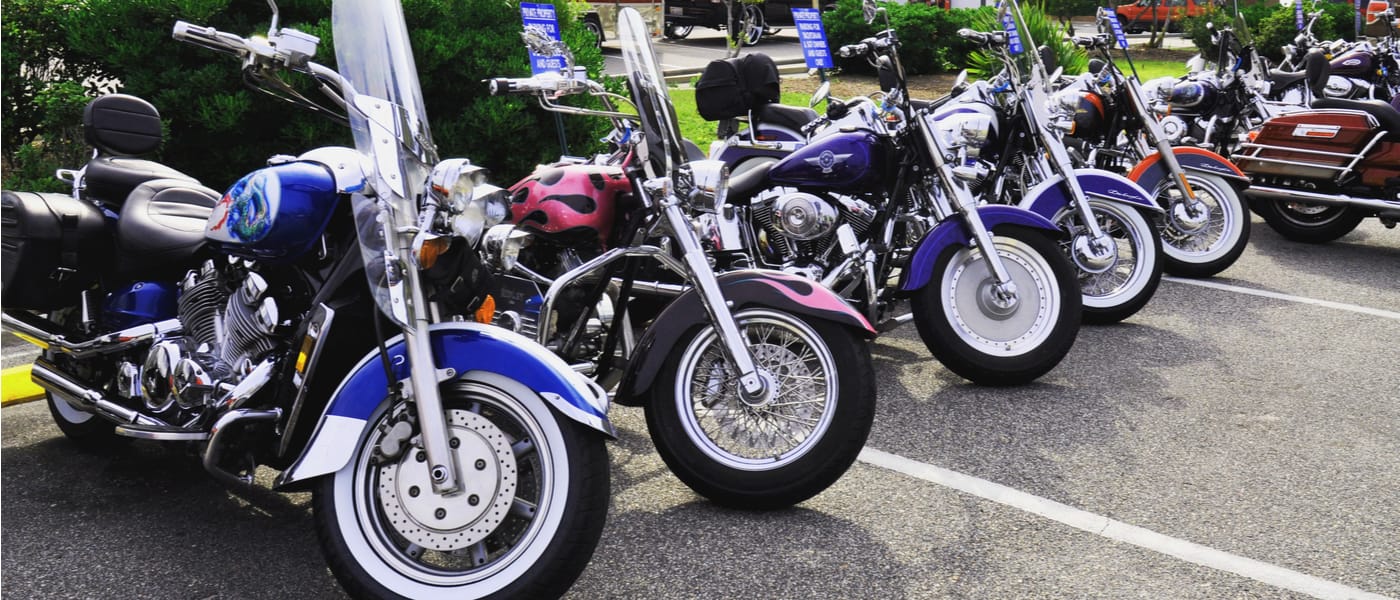If you’ve bought a new (or new-to-you) motorcycle, it’s time to think about insurance. While motorcycle insurance coverage is not required in every state, it’s still essential to help protect your investment. Most states require some form of minimum motorcycle coverage, but you can purchase additional coverage if you choose. The best way to determine what type of policy is right for your bike is by comparing rates and discount eligibility from multiple providers. We’ll break down the options below.
Motorcycle Insurance Cost Factors
When it comes to purchasing motorcycle insurance, there are several factors that can affect the cost. Here’s what you should know about each of them:
- The cost of the bike you’re insuring. If you want to insure your new Harley Davidson Fat Boy®, expect to pay more than if you were insuring a Honda Rebel 250cc. In general, larger bikes require higher premiums due to their greater body and engine size, which make them harder to repair in case of an accident.
- Your age and driving record play a role in determining how much motorbike insurance costs as well. Younger riders tend to have less experience riding motorcycles than older ones (obviously), so their premiums will reflect this inexperience with higher rates than those for older riders who have had more time on two wheels under them—especially if they’ve also never been involved in any accidents or traffic violations while driving motor vehicles before!
- here you live makes a difference too—generally speaking, residents living in rural areas will end up paying less for coverage than those who call city streets home because there aren’t as many opportunities for someone with poor safety habits like texting while driving around town where these types would need emergency care after something terrible happens such as hitting another car head-on while texting behind the wheel…and then having no health insurance coverage!
What Is Included in a Motorcycle Insurance Policy?
An insurance policy is a legal contract between an insurer and an insured that specifies the rights, responsibilities and liabilities of both parties. There are four types of coverage included in a motorcycle insurance policy: liability, collision, comprehensive and medical payments coverage.
- Liability insurance covers damage you cause to another person’s property or injuries you cause to another person by operating your motorcycle. It may also cover legal defense costs if you’re sued for damages caused by an accident while riding your motorcycle. Liability insurance also pays for other injuries sustained when riding on public roads or highways (e.g., police officer who gets hurt while stopping traffic after an accident). In most states, you are required to carry at least $20,000 in liability coverage per person injured in the event of an accident caused by your negligence while driving—and $40,000 total per incident excluding yourself as a driver (for example: if one passenger was injured along with several drivers).
- Collision insurance covers damage done directly from hitting something else such as another car or tree; it does not include any incidental costs associated with fixing dents or scratches made by other drivers hitting yours! This type of coverage typically requires filing claims directly through the company instead of taking care of those expenses out-of-pocket before sending them along for reimbursement later on down the road when all is said and done—which sounds pretty straightforward until something goes wrong (which happens surprisingly often!). If there aren’t enough funds available within this type’s limits then there won’t be anything left over after deductibles have been paid out which means someone else might end up having their own insurance carrier paying off claims instead – leaving them completely responsible afterwards!
How to Compare Motorcycle Insurance Rates and Discounts
Motorcycle insurance rates vary from company to company, but when you’re shopping for coverage, there are a few things you can do to ensure that you get the best deal.
- Compare motorcycle insurance rates online. The first thing to do is compare motorcycle insurance rates through an online source. A reputable website will offer unbiased information about multiple companies and their policies. If you’re not sure where to start, ask friends or family members for recommendations and conduct a Google search.
- Ask your insurance agent for advice. In addition to reaching out for recommendations from friends and family, it’s also worth talking with your current car or home insurer about their experiences with motorcycle policies from different companies in the past year or two so they can give some insight into which insurer may be best suited for your needs if you don’t want to go through an online comparison service (though we highly recommend doing both!)
Does Motorcycle Insurance Cover Custom Parts?
To find out if your insurance company covers custom parts, call the number on your policy and ask. If you haven’t been given a phone number for this purpose, call the main number and tell them that you have a question about motorcycles and need to be connected with an agent. If they refuse to connect you with an agent, hang up and call back again until they do so—they’ve got to be able to help you in some way!
Once someone is listening on the other end (or if it’s a recorded message), give them details about what kind of bike you own. Be sure not only include its name but also any specific brands or styles of its custom parts—if possible try bringing along photos of yourself riding around town with that specific bike in order to jog their memory! It may take several attempts before someone can identify which batch of coverage applies specifically toward customized motorcycles like yours, but once they do get back in touch just make sure everything sounds good before hanging up again.
Minimum Motorcycle Insurance Coverage Requirements
There are several minimum requirements for motorcycle insurance coverage. These requirements vary by state. However, most states require you to carry liability coverage on your motorcycle. Liability coverage protects you in the event that you injure someone or damage their property when riding the bike, as well as if they sue you and win a civil suit against you.
Insurance companies will also ask to see proof of financial responsibility before they issue any kind of insurance policy for motorcycles. This is because motorcyclists face higher risks than other drivers, so having insurance is especially important for them—especially since some people may not have adequate financial resources to pay for damages if they cause an accident while on their bikes.
The amount of liability protection required varies by state but typically covers bodily injury per person up to $50k/$100k total per accident; property damage up to $25k/$50k total per accident; medical payments up to $10k/$20k total per accident; uninsured motorist bodily injury/property damage coverages; plus uninsured motorist medical payments coverages where applicable
Required Motorcycle Safety Gear and Equipment
Before you can even get your license, you’ll have to pass a motorcycle safety course. If you don’t have time for that, there’s still the written exam and driving test. You’ll also need a motorcycle safety helmet and eye protection (like goggles), as well as ankle protection like boots or over-pants with Kevlar panels. Gloves are essential—you should choose them based on how often you’re going to be riding and whether or not they’ll protect your hands in an accident; some gloves also come with gel inserts that provide extra comfort. The same goes for pants: choose ones made from durable material if possible, but even jeans will do in a pinch. And make sure your shoes are sturdy enough to handle whatever terrain might come up during your ride!
Lastly (but definitely not least!) is protective gear for every part of your body: jacket (to keep wind chill out), back protector (for impact absorption), rain suit (to keep chilly weather at bay) and finally windscreen (to deflect bugs). In addition to these essentials are tools like screwdrivers or Allen wrenches so that if something goes wrong while on the road—and it will happen eventually—you’ll be able to fix it yourself instead of being stranded until someone comes along who has those tools themselves.
How Do I Report a Claim to My Motorcycle Insurance Company?
The first step in reporting a claim is to contact your motorcycle insurance company. If you need to file an insurance claim, it’s best to call the agent who sold you your policy. If you don’t know who your agent is or how to contact them, simply call the toll-free phone number on the back of your motorcycle insurance card and ask them for their details.
Your second option is calling the claims department of whichever company supplied the coverage in question. The website will give specific instructions for contacting their claims department based on what kind of claim has been made and whether or not there are other parties involved in any way. Remember that some companies have 24/7 emergency services available—so if something happens after hours and requires immediate attention, follow these steps from start to finish!
Typical Exclusions for Your Motorcycle Insurance Policy
Many insurance policies will exclude the following from coverage:
- Theft. If the bike is stolen, you’re out of luck. Your policy won’t pay for any medical costs or replacement fees associated with the loss of your motorcycle, even if it was taken by someone who wasn’t authorized to drive it.
- Vandalism and fire damage.* Damage to your motorcycle itself.* Theft of personal belongings from inside or on top of the bike (such as purses or helmets).
Motorcycle Insurance is a Must!
Motorcycle insurance is a valuable investment that can protect you from the financial consequences of an accident or other damage to your bike. The number of motorcycles on the road has increased dramatically in recent years, and more people are enjoying the thrill and convenience of riding them.


How To Choose A Side By Side
Side by sides, also known as utility task vehicles (UTVs), have revolutionized the way we explore and conquer challenging landscapes. We’ll be going over
Jul
Top Motorcycles For Long Distance Riding
Picture yourself cruising down a never-ending highway, the wind in your hair and the open road beckoning you forward. For motorcycle enthusiasts, long-distance riding
Jun
Everything To Know About Gas vs Electric Dirt Bikes
Revving engines, flying dirt, and adrenaline-fueled adventures – the world of dirt biking has always been synonymous with raw power and rugged excitement. However,
May